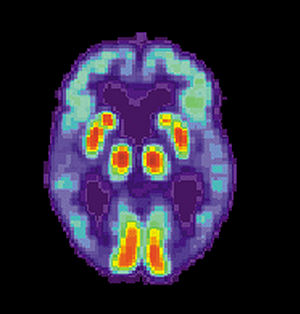
Ultimately, the reduction totaled 75 percent
Neuroscientists at Case Western Reserve University School of Medicine have made a dramatic breakthrough in their efforts to find a cure for Alzheimer’s disease. The researchers’ findings, published in the journal Science, show that use of a drug in mice appears to quickly reverse the pathological, cognitive and memory deficits caused by the onset of Alzheimer’s. The results point to the significant potential that the medication, bexarotene, has to help the roughly 5.4 million Americans suffering from the progressive brain disease.
Bexarotene has been approved for the treatment of cancer by the U.S. Food and Drug Administration for more than a decade. These experiments explored whether the medication might also be used to help patients with Alzheimer’s disease, and the results were more than promising.
Alzheimer’s disease arises in large part from the body’s inability to clear naturally-occurring amyloid beta from the brain. In 2008 Case Western Reserve researcher Gary Landreth, PhD, professor of neurosciences, discovered that the main cholesterol carrier in the brain, Apolipoprotein E (ApoE), facilitated the clearance of the amyloid beta proteins. Landreth, a professor of neurosciences in the university’s medical school, is the senior author of this study as well.
Landreth and his colleagues chose to explore the effectiveness of bexarotene for increasing ApoE expression. The elevation of brain ApoE levels, in turn, speeds the clearance of amyloid beta from the brain. Bexarotene acts by stimulating retinoid X receptors (RXR), which control how much ApoE is produced.
In particular, the researchers were struck by the speed with which bexarotene improved memory deficits and behavior even as it also acted to reverse the pathology of Alzheimer’s disease. The present view of the scientific community is that small soluble forms of amyloid beta cause the memory impairments seen in animal models and humans with the disease. Within six hours of administering bexarotene, however, soluble amyloid levels fell by 25 percent; even more impressive, the effect lasted as long as three days. Finally, this shift was correlated with rapid improvement in a broad range of behaviors in three different mouse models of Alzheimer’s.
One example of the improved behaviors involved the typical nesting instinct of the mice. When Alzheimer’s-diseased mice encountered material suited for nesting — in this case, tissue paper — they did nothing to create a space to nest. This reaction demonstrated that they had lost the ability to associate the tissue paper with the opportunity to nest. Just 72 hours after the bexarotene treatment, however, the mice began to use the paper to make nests. Administration of the drug also improved the ability of the mice to sense and respond to odors.
Bexarotene treatment also worked quickly to stimulate the removal of amyloid plaques from the brain. The plaques are compacted aggregates of amyloid that form in the brain and are the pathological hallmark of Alzheimer’s disease. Researchers found that more than half of the plaques had been cleared within 72 hours. Ultimately, the reduction totaled 75 percent. It appears that the bexarotene reprogrammed the brain’s immune cells to “eat” or phagocytose the amyloid deposits. This observation demonstrated that the drug addresses the amount of both soluble and deposited forms of amyloid beta within the brain and reverses the pathological features of the disease in mice.
Read more . . .
Bookmark this page for “Alzheimers” and check back regularly as these articles update on a very frequent basis. The view is set to “news”. Try clicking on “video” and “2” for more articles.








